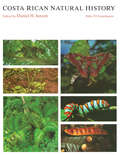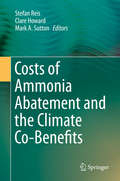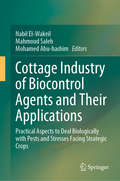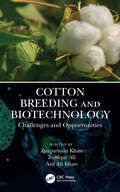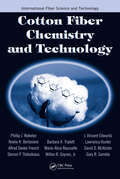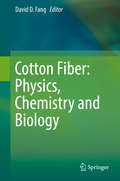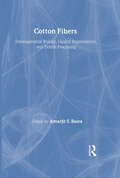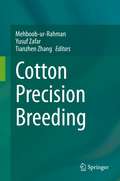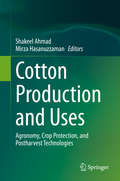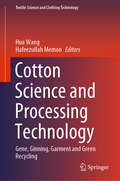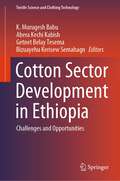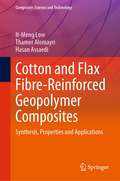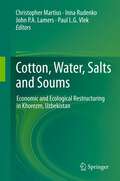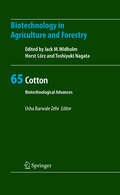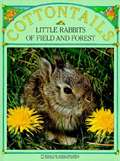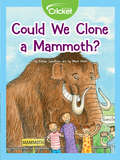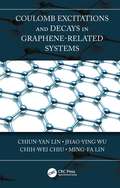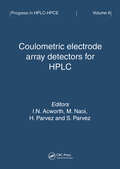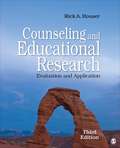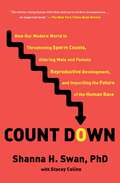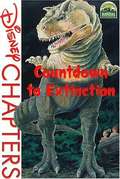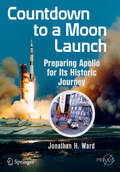- Table View
- List View
Costa Rican Natural History: With 174 Contributors
by Daniel H. JanzenThis volume is a synthesis of existing knowledge about the flora and fauna of Costa Rica. The major portion of the book consists of detailed accounts of agricultural species, vegetation, amphibians, reptiles, mammals, birds, and insects. "This is an extraordinary, virtually unique work. . . . The tremendous amount of original, previously unpublished, firsthand information is remarkable."—Peter H. Raven, Director, Missouri Botanical Garden "An essential resource for anyone interested in tropical biology. . . . It can be used both as an encyclopedia—a source of facts on specific organisms—and as a source of ideas and generalizations about tropical ecology."—Alan P. Smith, Ecology
Costs And Returns For Agricultural Commodities: Advances In Concepts And Measurement
by Mary AhearnPolicymakers, farmers, managers of agriculture and others look to agricultural economists for accurate estimates of the costs and returns of individual agricultural commodities. But there is great diversity and disagreement among practitioners about the best method for such analysis. The contributors to this volume explore how different uses of estimates determine different methods of estimation, as well as evaluating what the preferred methods are for similar uses.
Costs of Ammonia Abatement and the Climate Co-Benefits
by Mark A. Sutton Stefan Reis Clare HowardThis book examines the costs involved in reducing ammonia emissions from agricultural practices as well as the potential benefits for climate change mitigation. It features contributions by experts in agricultural production processes, producers of agricultural equipment and service providers as well as scientists who assess the issue from an European perspective. Coverage examines all agricultural production stages starting from animal feed and housing, including the storage and application of liquid and solid manure and of mineral fertilizer. In addition, the book looks at the relationship between ammonia control and greenhouse gas emissions and details the GAINS (Greenhouse Gas and Air Pollution Interactions and Synergies) model for estimating costs and reducing ammonia emissions from agriculture. Examples and case studies from select European countries, including Italy, Switzerland, Russia, Ireland, and Spain, provide readers with detailed studies of ammonia abatement costs and the effectiveness of implementing control measures under different conditions. This book is the result of an Expert Workshop held under the auspices of the UNECE Convention on Long-range Transboundary Air Pollution (CLRTAP) and organised by the Task Force on Reactive Nitrogen (TFRN). The findings of this workshop have informed the development of documents supporting the revision of the Gothenburg Protocol and provided researchers and practitioners with vital new data. Bringing together a wealth of key information on the costs of ammonia abatement and the climate co-benefits, this monograph provides readers with deep insight into this complex issue.
Coteaching in International Contexts: Research and Practice (Cultural Studies of Science Education #1)
by Kathryn Scantlebury Colette MurphyCoteaching is two or more teachers teaching together, sharing responsibility for meeting the learning needs of students and, at the same time, learning from each other. Working as collaborators on every aspect of instruction, coteachers plan, teach and evaluate lessons together. Over the past decade, because coteaching can be highly beneficial to both students and teachers it has become an increasingly important element of science teacher education and is expanding into other content areas and educational settings. This edited book brings together ten years' work on the research and the practice of coteaching and its impact on teaching and learning, predominantly in the sciences. It includes contributions from Europe, United States and Australia and presents an doverview of theory and practice common to most studies.
Cottage Industry of Biocontrol Agents and Their Applications: Practical Aspects to Deal Biologically with Pests and Stresses Facing Strategic Crops
by Mohamed Abu-Hashim Nabil El-Wakeil Mahmoud SalehThis book analyses the mass production and application of biological control products for biotic and abiotic factors affecting agricultural production. It also describes how to develop sustainable agriculture under Egyptian conditions. The book is divided into four parts covering: 1) mass production of parasitoids, insects and mite predators, 2) mass production of the microbial control agents for managing insect pests, 3) biocontrol products for plant diseases, and 4) bioproducts against abiotic factors. It discusses various methods of controlling insect pests and plant diseases in order to increase agricultural production, improve the quality of field crops and reduce the food gap by applying a range of technologies. This book helps increase our understanding and awareness of how to produce healthy products for local consumption and utilization as well as for exports.
Cotton Breeding and Biotechnology: Challenges and Opportunities
by Zulfiqar Ali Zulqurnain Khan Asif Ali KhanCotton Breeding and Biotechnology presents information on one of the most economically important crops of the world, cotton. This book contains chapters on the history of cotton; breeding approaches; technologies for increasing germination, crop growth and yield; and fiber quality issues. It emphasizes sustainable development in the cotton industry analysing the progress of breeding technologies under environmental adversity. The book explores the national and global status of cotton crop, including cotton production, possible impacts of climate change, and the vulnerability of cotton to pest infestations and disease attacks. Features Focuses on cotton breeding and biotechnology Proposes ideas, data, and strategies to mount breeding programs for enhancing cotton production Details strategies for cotton quality improvement against abiotic and biotic stresses Emphasizes the revival of cotton in Pakistan and South Asian region This book is useful to researchers, cotton breeders and growers, farmers, and the agriculture industry.
Cotton Fiber Chemistry and Technology
by Phillip J. Wakelyn Noelie R. Bertoniere Alfred D. French Devron P. Thibodeaux Barbara A. Triplett Marie-Alice Rousselle Wilton R. Goynes Jr. J. Vincent Edwards Lawrance Hunter David D. McAlister Gary R. GambleAnnual cotton production exceeds 25 million metric tons and accounts for more than 40 percent of the textile fiber consumed worldwide. A key textile fiber for over 5000 years, this complex carbohydrate is also one of the leading crops to benefit from genetic engineering. Cotton Fiber Chemistry and Technology offers a modern examination of co
Cotton Fiber: Physics, Chemistry and Biology
by David D. FangCotton fiber is the most important natural fiber used in the textile industry. The physical structure and chemical compositions of cotton fibers have been extensively studied. Newer high speed spinning instruments are being deployed around the world that demand longer, stronger and finer fibers. Consequently, genetic improvement in fiber quality has been stressed. With improvement in fiber quality has come the realization that further fiber improvement will require a better understanding of fiber development and biology. As a consequence, cotton fiber developmental biology, genetics and genomics have become focal points in the cotton research community. As the longest single-celled plant hair, cotton fiber has been used as an experiment model to study trichome initiation and elongation in plants. This book provides a comprehensive update on cotton fiber physics, chemistry and biology that form the three sections of the book. In the physics section, the physical structure of cotton fiber is first illustrated in great detail. Then a suite of fiber properties and their measuring methods are described. The pros and cons of each method are outlined. New methods to measure physical properties of single fiber and young developing fibers are included. In the chemistry section, the chemical compositions of cotton fibers are described in detail. This knowledge is necessary for efficient modification of cotton fibers for better and broader utilization. The advancement in cotton fiber modification using chemical and enzymatic methods opened new ways to utilize cotton fibers. In the biology section, the book first introduces the utilization of naturally occurring color cottons. Color cottons possess unique attributes such as better fire retardant ability. Advancement in understanding fiber color genetics and biochemical pathways and new utilization of color cottons are discussed. Recent technological advancements in molecular biology and genomics have enabled us to study fiber development in great depth. Many genes and quantitative trait loci related to fiber quality attributes have been identified and genetically mapped. Some of these genes and QTLs are being used in breeding. Progresses in cotton fiber improvement using breeding and biotechnology are discussed in the last chapter. This book serves as a reference for researchers, students, processors, and regulators who either conduct research in cotton fiber improvement or utilize cotton fibers.
Cotton Fibers: Developmental Biology, Quality Improvement, and Textile Processing
by Amarjit S. BasraExplore new and proven information about cotton fibers!Cotton Fibers is an important reference source for anyone who produces, markets, and researches cotton fibers. This unique book is written by internationally renowned researchers who have pooled their immense knowledge to create this outstanding volume that deals with development, quality improvement, and textile/technological aspects of cotton production. Cotton, a worldwide crop that is valued at $20 billion, is the premiere natural fiber for textiles. As cotton fiber consumption continues to increase, the crop is becoming a major importance to the economies of both developed and developing countries. Cotton Fibers covers the recent explosion of information on cotton fibers and points out research priorities for the future, consequently stimulating multidisciplinary cotton research. Cotton Fibers provides you with information on topics that will help you improve the quantity and quality of cotton crops, such as: developing cotton fibers in vitro developing cellulose biosynthesis in cotton fibers modifying cotton fibers with genetic engineering strategies managing postharvest fiber quality abating air pollution and disposal of gin waste fiber-to-fabric engineering for optimal cotton fiber quality structural development of cotton fibers and linkages to fiber quality cotton germplasam resources and their potential for improved fiber productivity and quality molecular genetics of developing cotton fibersComplete with charts and diagrams, Cotton Fibers is a thorough exploration of what is known about cotton fibers and what research is just beginning to reveal about the crop. You will explore some of the latest technological advances in cotton fiber production, such as understanding the genetics of fiber growth and development and introducing hormone genes into cotton. This comprehensive guide is a vital tool for anyone interested in increasing the yield and quality of cotton, the world's most popular fiber.
Cotton Precision Breeding
by Mehboob-Ur-Rahman Yusuf Zafar Tianzhen ZhangCotton, the most important natural fiber crop, has been improved by conventional breeding—largely through planned hybridization of different cotton genotypes, since the discovery of Mendelian genetics. All these efforts resulted in the development of resilient high yielding cotton varieties. However, the progress through conventional breeding procedures is slow because of long lag periods for developing a variety, little control over the new genetic combinations, unwanted traits and lack of foolproof performance testing system. Genomic assays discovered over the last two decades have made it possible to understand the “language” of the genome by associating the genes with specific traits. Together with the more recently established gene-editing tools like CRISPR-Cas9, the cotton genome can be tailored much more precisely than ever before. In this regard, genetic information has been harnessed, through (i) sequencing of the progenitor and cultivated cotton species, (ii) ongoing mega pan-genome sequencing projects, (iii) genetic and physical mapping, and (iv) introgression of genes from alien sources, that resulted in the development of resilient cotton cultivars. These technologies have been deployed or are attempting to overcome the challenges of water shortage, excessive heat in most cotton growing regions, infectious diseases and infestation of insect pests, as well as rising production cost, for sustainable cotton production beyond 2030. In this book, new knowledge generated by the cotton research community and its application for developing resilient cotton are comprehensively summarized. This book contributed by well-known cotton researchers is a timely collection of the challenges and successes of precision cotton breeding in a changing environment.
Cotton Production and Uses: Agronomy, Crop Protection, and Postharvest Technologies
by Mirza Hasanuzzaman Shakeel AhmadThis book provides a comprehensive and systematic overview of the recent developments in cotton production and processing, including a number of genetic approaches, such as GM cotton for pest resistance, which have been hotly debated in recent decades. In the era of climate change, cotton is facing diverse abiotic stresses such as salinity, drought, toxic metals and environmental pollutants. As such, scientists are developing stress-tolerant cultivars using agronomic, genetic and molecular approaches. Gathering papers on these developments, this timely book is a valuable resource for a wide audience, including plant scientists, agronomists, soil scientists, botanists, environmental scientists and extention workers.
Cotton Science and Processing Technology: Gene, Ginning, Garment and Green Recycling (Textile Science and Clothing Technology)
by Hua Wang Hafeezullah MemonThis book summarizes all different fields of cotton fiber, including genetics, fiber chemistry, soft materials, textile, and fashion engineering. It also contains some new applications such as biomaterials, nanocoated smart fabrics, and functional textiles. Moreover, the significant improvement recently in gene modification and gene technology is introduced. This book discusses all these aspects in a more straightforward way, and new illustrations will help readers to understand the contents. It is intended for undergraduate and graduate students who are interested in cotton science and processing technologies, researchers investigating the updated applications of cotton in various fields as well as industrialists who want to have a quick review of the cotton and its different stages.
Cotton Sector Development in Ethiopia: Challenges and Opportunities (Textile Science and Clothing Technology)
by Abera Kechi Kabish K. Murugesh Babu Getnet Belay Tesema Bizuayehu Kerisew SemahagnThis book highlights the development of cotton sector and its related issues, in Ethiopia. The book is a comprehensive collection of detailed chapters ranging from agricultural aspects of cotton, its value chain, and economics. It provides an overview of the cotton sector development and the challenges faced in the growth and extension of cotton production and research in three separate sections i.e., cotton agriculture, cotton fibre technology and cross-cutting issues in the cotton sector. In the first part of the book, agricultural aspects of cotton fibre production such as, cotton agronomy, genetics and breeding, biotechnology, mechanized production, crop harvesting management are discussed in detail. This is followed by chapters concerned to a comprehensive knowledge on cotton fibre demand and supply in Ethiopia, ginning technology and industries, cotton quality testing and grading, quality requirements for spinning, cotton fabric production, chemical processing aspects and therole of cotton fabrics in the Ethiopian fashion industry. The final section of the book deals with chapters on the cotton seed production techniques, cotton research and promotion, challenges in quality cotton production, cotton value chain and economics and sustainable cotton production. This book is a valuable resource for all those concerned with cotton biology and agriculture, production and extension, research and development, fashion industry, research and academia.
Cotton and Flax Fibre-Reinforced Geopolymer Composites: Synthesis, Properties and Applications (Composites Science and Technology)
by It-Meng Low Thamer Alomayri Hasan AssaediThis book provides an overview on the latest advances in the synthesis, properties and applications of geopolymers reinforced with natural fibres such as pulp fibre, cotton, sisal, flax and hemp. The influence of adding various natural fibres and nanofillers on the mechanical properties of these composites is discussed. Potential challenges and future directions of these composites are highlighted and addressed. The content of this book caters to students, researchers and academics who are interested in the synthesis and applications of geopolymers composites.
Cotton, Water, Salts and Soums: Economic and Ecological Restructuring in Khorezm, Uzbekistan
by Inna Rudenko P.L.G. Vlek John P.A. Lamers Christopher MartiusThis book summarizes a long-term research project addressing land and water use in the irrigated areas of the Aral Sea basin. In an interdisciplinary approach, natural and human sciences are combined to elucidate the challenges of economic transition that affect the use of land, water and biological resources, ecological sustainability, economic efficiency and the livelihoods of the local population. The research focuses on Khorezm, a region in Uzbekistan, located on the Amudarya river, in the heart of Central Asia. A series of chapters describes the biophysical environment and the aspects of society and institutions that shape land and water use. The book discusses options and tools to improve land and water management, and to reform the economic system management, based on agronomic, hydrological, economic ans social studies and modeling. The insights are not only important for Uzbekistan, but for all countries in transitions and irrigated dryland areas elsewhere.
Cotton: Biotechnological Advances (Biotechnology in Agriculture and Forestry #65)
by Usha Barwale ZehrThe growing global population poses the challenge to the scientific community of doubling or tripling the food, feed and fiber production by the year 2050. Biotechnology can make a significant contribution to this effort. This volume reviews the use of biotechnology in cotton, which is the leading plant fiber crop worldwide and grown commercially in more than 50 countries. Renowned experts highlight the success of Bt cotton, the introduction of second and third generation traits and the impact at all levels of farming. Furthermore, the molecular advances being made in cotton biotechnology and the potential traits that will come to market in the next decade are described in detail.
Cottontails
by Ron FisherHow the cottontail rabbit explores its environment, eats, washes, senses danger, rests, and cares for its young. Also describes wild and domestic rabbits around the world. Images are described.
Could We Clone a Mammoth?
by Esther LandhuisDuring the last Ice Age, large, hairy elephants roamed Asia and the Americas. But by about 4,000 years ago, all the mammoths and mastodons had vanished. Could these ancient beasts ever come back to life?
Could You Ever Dine with Dinosaurs!?
by Sandra MarkleSpend a day with carnivorous dinosaurs in this fantastic new series from Sandra Markle, the bestselling author of the What If You Had... series! What if you could spend a day with your favorite animals? What would you eat? How would you play? Would you ever want to leave?Pull up a chair and get ready to dine with carnivorous dinosaurs in the third book in the Could You Ever... series! Learn all about what different meat-eating dinosaurs feasted on, when they lived, and more! This innovative book places kids right into the action as they learn all about these amazing creatures.With imaginative, interactive text from bestselling author Sandra Markle and engaging art from Vanessa Morales, this book is sure to be a kid favorite!
Coulomb Excitations and Decays in Graphene-Related Systems
by Ming-Fa Lin Chiun-Yan Lin Jhao-Ying Wu Chih-Wei ChiuCoulomb Excitations and Decays in Graphene-Related Systems provides an overview of the subject under the effects of lattice symmetries, layer numbers, dimensions, stacking configurations, orbital hybridizations, intralayer and interlayer hopping integrals, spin-orbital couplings, temperatures, electron/hole dopings, electric field, and magnetic quantization while presenting a new theoretical framework of the electronic properties and the electron-electron interactions together. This book presents a well-developed theoretical model and addresses important advances in essential properties and diverse excitation phenomena. Covering plenty of critical factors related to the field, the book also addresses the theoretical model which is applicable to various dimension-enriched graphene-related systems and other 2D materials, including layered graphenes, graphites, carbon nanotubes, silicene, and germanene. The text is aimed at professionals in materials science, physics, physical chemistry, and upper level students in these fields.
Coulometric Electrode Array Detectors for HPLC
by M. Naoi H. Parvez S. Parvez I. N. AcworthThis sixth volume in the book series Progress in HPLC-HPCE examines the enhancement of high- performance liquid chromatography through the development of an advanced mode of electrochemical detection (ECD) --- the coulometric array detection --- from its initial, yet problematic, amperometric (thin-layer) design to the highly sensitive, selective and stable coulometric (flow-through) design. Unlike amperometric electrodes, the coulometric electrode is 100% efficient and measures signals from all of the analyte passing through it, which leads to improved sensitivity as well as unique selectivity. The coulometric electrode array offers the resolution of the photodiode array with the extreme sensitivity of an electrochemical detector.
Counseling And Educational Research: Evaluation And Application, 3rd Edition
by Rick A. HouserThe Third Edition of Counseling and Educational Research: Evaluation and Application emphasizes the importance of being a good consumer of research and teaches readers how to conduct research in practice. Written in an engaging, conversational tone, the book uses concrete examples from professional literature to demonstrate how to effectively evaluate and interpret research articles--without relying on discipline-specific jargon. The Third Edition features new examples, updated research, a new chapter on single-subject research, a new chapter on the use of technology and research, and much more.
Count Down: How Our Modern World Is Threatening Sperm Counts, Altering Male and Female Reproductive Development, and Imperiling the Future of the Human Race
by Stacey Colino Shanna H. SwanIn the tradition of Silent Spring and The Sixth Extinction, an urgent, &“disturbing, empowering, and essential&” (Kirkus Reviews, starred review) book about the ways in which chemicals in the modern environment are changing—and endangering—human sexuality and fertility on the grandest scale, from renowned epidemiologist Shanna Swan.In 2017, author Shanna Swan and her team of researchers completed a major study. They found that over the past four decades, sperm levels among men in Western countries have dropped by more than 50 percent. They came to this conclusion after examining 185 studies involving close to 45,000 healthy men. The result sent shockwaves around the globe—but the story didn&’t end there. It turns out our sexual development is changing in broader ways, for both men and women and even other species, and that the modern world is on pace to become an infertile one. How and why could this happen? What is hijacking our fertility and our health? Count Down unpacks these questions, revealing what Swan and other researchers have learned about how both lifestyle and chemical exposures are affecting our fertility, sexual development—potentially including the increase in gender fluidity—and general health as a species. Engagingly explaining the science and repercussions of these worldwide threats and providing simple and practical guidelines for effectively avoiding chemical goods (from water bottles to shaving cream) both as individuals and societies, Count Down is &“staggering in its findings&” (Erin Brockovich, The Guardian) and &“will serve as an awakening&” (The New York Times Book Review).
Countdown to Extinction
by Barbara Gaines WinkelmanChildren's book about the study and research into dinosaurs that have become extinct.
Countdown to a Moon Launch: Preparing Apollo for Its Historic Journey (Springer Praxis Books)
by Jonathan H. WardThousands of workers labored at Kennedy Space Center around the clock, seven days a week, for half a year to prepare a mission for the liftoff of Apollo 11. This is the story of what went on during those hectic six months. Countdown to a Moon Launch provides an in-depth look at the carefully choreographed workflow for an Apollo mission at KSC. Using the Apollo 11 mission as an example, readers will learn what went on day by day to transform partially completed stages and crates of parts into a ready-to-fly Saturn V. Firsthand accounts of launch pad accidents, near misses, suspected sabotage, and last-minute changes to hardware are told by more than 70 NASA employees and its contractors. A companion to Rocket Ranch, it includes many diagrams and photographs, some never before published, to illustrate all aspects of the process. NASA's groundbreaking use of computers for testing and advanced management techniques are also covered in detail. This book will demystify the question of how NASA could build and launch Apollo missions using 1960s technology. You'll discover that there was no magic involved - just an abundance of discipline, willpower, and creativity.
